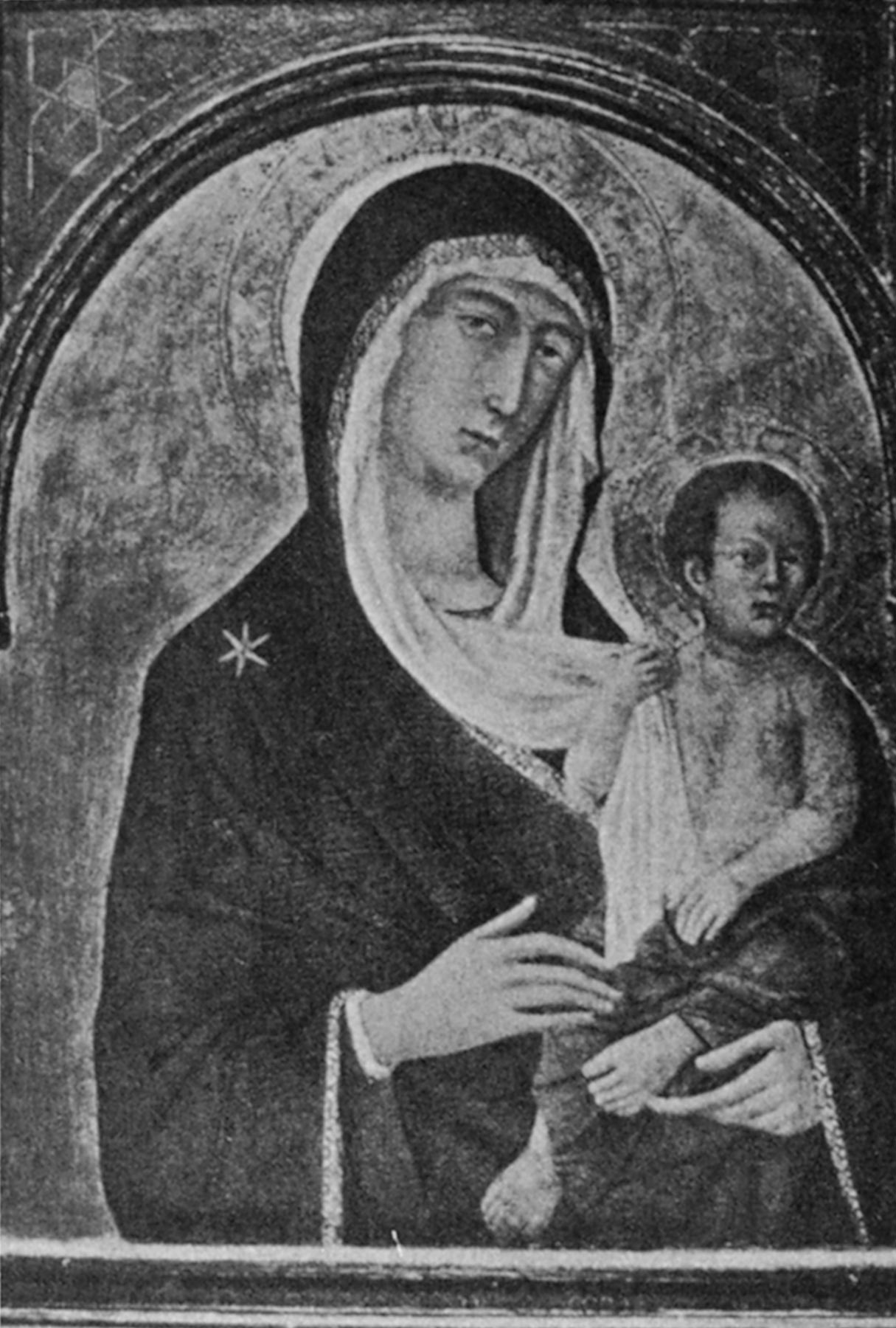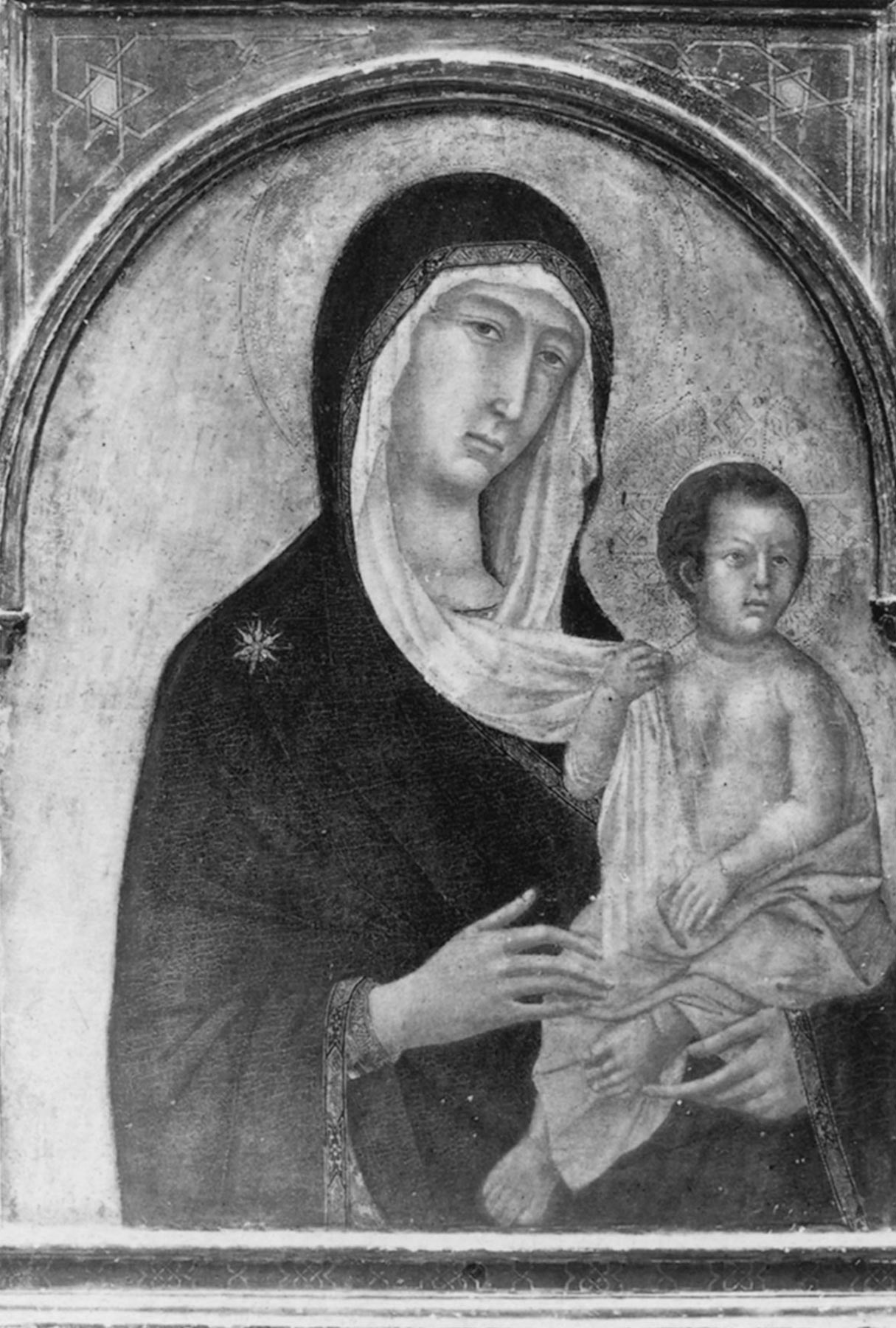Convent of Santa Chiara, San Miniato al Tedesco (Pisa);1 Charles Loeser (1864–1928), Florence, by 1908; Achillito Chiesa (1881–1951), Milan; sale, American Art Association, New York, November 27, 1925, lot 54; Samuel L. Fuller (1875–1963), Martha’s Vineyard, Mass.; sale, Sotheby’s, New York, June 11, 1981, lot 107; sale, Christie’s, London, July 4, 1991, lot 73; Luigi Grassi, Florence; John Treacy Beyer (born 1943) and Darcy Fisher Beyer (1943–2022), Washington Depot, Conn., 2000
The panel support, of a vertical wood grain, retains its original thickness of 3.2 centimeters. The painted spandrel decoration comprises an 8-millimeter-thick panel, vertically grained, applied to the face of the support at the top. The right half of this decoration is largely original; the center (above the apex of the arch) and left half is a modern reconstruction. The engaged top molding above the spandrel is modern and has been shaped to follow the pronounced convex warp of the panel. The vertical moldings alongside the spandrel are partly original and partly modern repairs. The projecting molding of the arched frame is substantially original but regessoed and regilt; its right supporting corbel may be original, but the left corbel is a modern carved replacement. Nails, driven in front to back, once securing a horizontal batten, are plainly visible on the reverse at 60.5 and 61 centimeters from the bottom edge of the panel; discoloration of the wood on the reverse of the panel suggests that this batten was approximately 8 centimeters wide. Two holes that may indicate the placement of similar nails securing a second batten or the lower molding of the altarpiece frame are visible at 1.5 centimeters from the bottom edge, implying that the panel has been cropped at this edge by 2 to 3 centimeters. Dowel holes are drilled along the left edge of the panel at 13 and 59 centimeters from the bottom and along the right edge at 15 and 59 centimeters from the bottom. The predella molding applied to the front of the panel is modern.
The entire gold ground of the picture surface is modern, applied over the original gesso preparatory layer sometime between 1912 and 1925. The picture surface is evenly abraded throughout, more so in the flesh tones, where the terra verde underpaint is too prominently visible. Losses in the Virgin’s cowl, right shoulder and sleeve, and right wrist have been unevenly retouched, and damages to her left eye and scattered throughout the face and neck of the Christ Child have been reconstructed. The Child’s hair and the deeper shadows in His red draperies and in the Virgin’s white veil have been reinforced. The mordant gilt decoration is substantially original but repaired. An irregular line of damage across the bottom 6 to 7 centimeters of the paint surface has resulted in two areas of total loss: in the blue of the Virgin’s robe at the lower-right corner of the panel and to the right of center above the predella, including the entirety of the Child’s right foot and the fold of drapery beneath it. The glimpse of red lining in the Virgin’s cloak just to the left of this area is a modern invention.
From the time of its first appearance in the scholarly literature, this Virgin and Child has been considered part of a group of works clustered around the name of Duccio’s best-known follower, one of only two whose names are preserved in the historical record: Segna di Bonaventura.2 For Langton Douglas, the painting was an early example of the output of Duccio’s own workshop, while F. Mason Perkins assigned it directly to Segna, calling it “a work of exceptional refinement that clearly reveals the uncommon gifts of this too little appreciated follower of Duccio.”3 It was lent by its owner, Charles Loeser, to the 1912 exhibition in Siena of the work of Duccio and his followers, where it was catalogued by Giacomo De Nicola as from the circle of Segna and described as sensitively restored.4 De Nicola, in his Burlington Magazine review of (or publicity for?) the exhibition, discussed the painting as by Segna himself, although the caption published alongside the photograph accompanying his article calls it the work of Segna’s son, Niccolò di Segna.5 He specifically mentioned the successful restoration of the painting by Luigi Cavenaghi as having brought forward its finest features. Cavenaghi’s restoration, as it is recorded in the early Lombardi photographs of the painting that were known to this first generation of Duccio scholars (fig. 1), included a new gold ground, deftly enhanced shadows that had been lost to abrasion, and local repairs to losses chiefly in the figure of the Christ Child and in the Virgin’s left eye. These may account, in part, for the vacillation of opinions in the literature, a vacillation to which the study of Sienese Ducciesque painting is in any event subject. Raimond van Marle listed the painting twice, once without discussion as a work by Segna and once as “perhaps the finest” member of a group of paintings in Segna’s orbit, most of which have since been recognized as by a slightly younger follower of Duccio: Ugolino da Siena.6 Curtis Weigelt doubted the integrity of van Marle’s grouping and returned the painting generically to the school of Duccio or orbit of Segna di Bonaventura, comparing it to a related image of the Virgin and Child in Asciano (see fig. 3).7 Cesare Brandi listed it in passing as one of a number of Ducciesque works.8 James Stubblebine, in his comprehensive review of this important school of painting, seized on the differences between this painting and the more monumental, angular, and dramatic works that he accepted as Segna’s.9 Perhaps following a suggestion derived from De Nicola’s 1912 Burlington Magazine article, he assigned the painting to Segna’s son, Niccolò di Segna, as a probable early work executed within or immediately upon graduation from his father’s shop, probably around 1330. At least four of the six paintings that he placed in this category, including the Asciano Virgin and Child cited by Weigelt, are now widely recognized as autograph works by Segna di Bonaventura.10
It is not known when the Yale painting might have been sold by Charles Loeser to Achillito Chiesa, but sometime before it appeared at the Achillito Chiesa auction sale in New York in 1925, it underwent another, more radical restoration that removed much of Cavenaghi’s strengthening of forms and replaced the new gold ground that he had added with an artificially “aged” gilding, replete with its own craquelure and with induced passages of wear and abrasion. This was achieved by gilding atop a sheet of linen—a technique outlined by Icilio Federico Joni in his autobiographical Memorie di un pittore di quadri antichi11—which was then carefully cut around the silhouette of the Virgin and Child and glued atop the remnants of original gesso on the panel. While superficially enhancing the gestalt of the image, the discontinuity of the crackle patterns between the gilded and painted surfaces, as well as a barely perceptible line of gesso reserve created by shrinkage of the added linen and gilding, served to exaggerate the appearance of a hard profile around the figures typical of a slightly later and more decorative generation of painters. This state of the painting is recorded in a photograph by Girolamo Bombelli (fig. 2) that is certainly the source of Stubblebine’s confusion with the style of Niccolò di Segna.12 A third restoration, by Gabriella Kopelman, following the painting’s sale at auction in 1981, corrected discolored repaints over local losses and replaced the badly proportioned right foot of the Christ Child (an area of total loss) that had been provided by the Chiesa restoration with the slightly foreshortened version now in evidence.
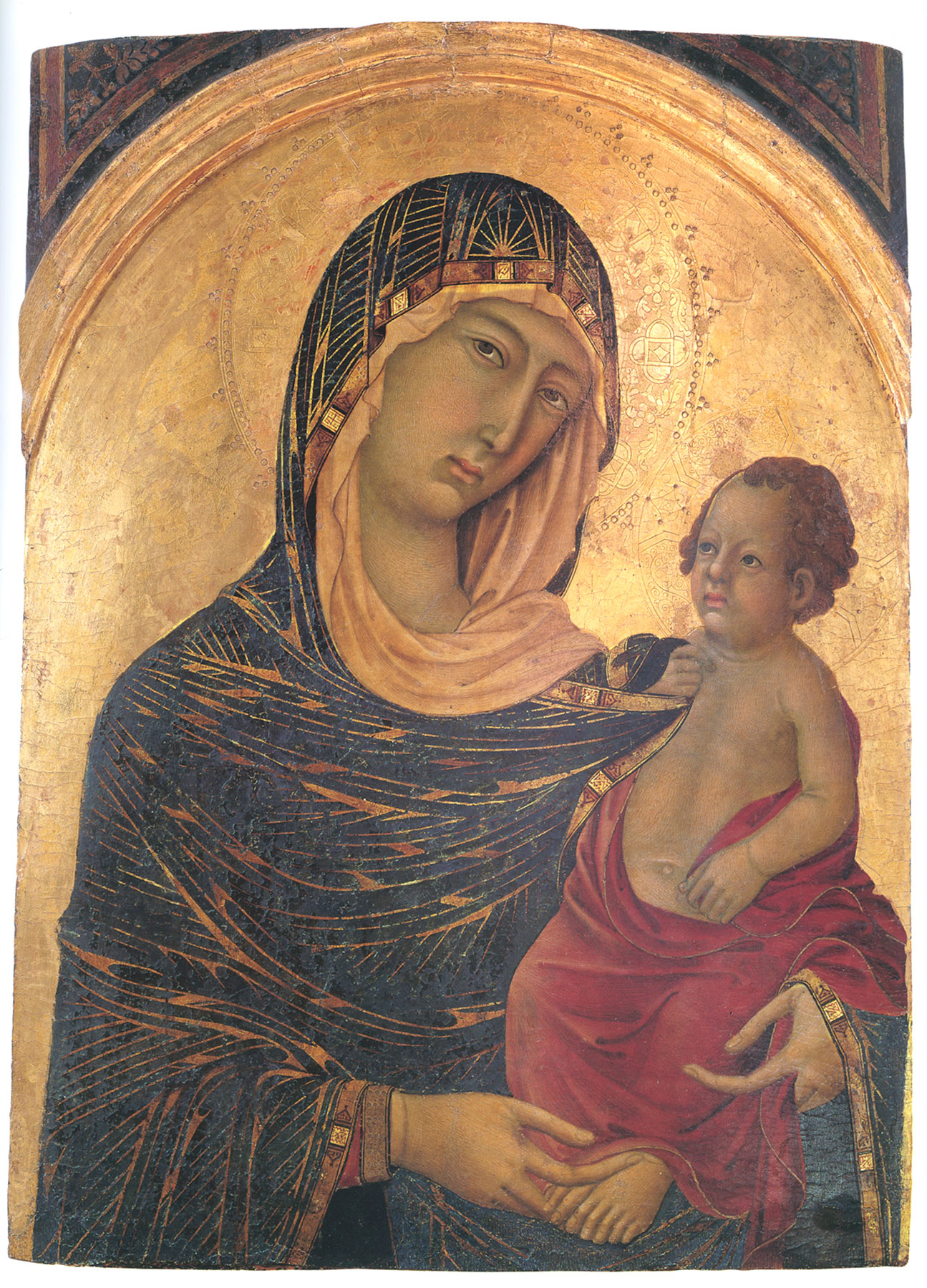
Reconsidering not only attributions to Segna but also the probable chronology of his work, Luciano Cateni adduced the Asciano Virgin and Child (fig. 3), correctly, as an example of the artist’s earliest efforts, possibly still within the first decade of the fourteenth century, rather than a later simplification and reduction of his mature style. It, like the Yale Virgin and Child, reflects awareness of Duccio’s accomplishments before the unveiling in 1312 of the Maestà in Siena Cathedral, being instead dependent on works such as the Perugia Madonna (ca. 1300–1305) (see Attributed to Ugolino di Nerio, Virgin and Child Enthroned with Four Saints, fig. 5) or Polyptych 28 in the Pinacoteca Nazionale, Siena (ca. 1305–10). Also indicative of an early date are the squat proportions of the picture field in the Asciano and Yale panels and the unusual asymmetry of the painting now at Yale, although the volume of empty space (i.e., gold ground) around the figures, noted by Stubblebine as more typical of earlier periods, is actually exaggerated by repainting of the Virgin’s silhouette considerably shy of the engraved line in the gesso still visible in an X-radiograph (fig. 4). The compositional relationship of the Child to His mother—pulling at her veil while looking not at her directly but out of the picture field, toward the right—is also found only in a small number of other Sienese paintings all datable before 1315. The eponymous work by the Master of Città di Castello, which probably dates at or shortly before the turn of the thirteenth century, might be considered a prototype for the composition of the Yale painting, while the slightly later Polyptych 33 in the Pinacoteca Nazionale, Siena, by the same artist (fig. 5) shows the Child pulling at His mother’s index finger instead of her veil, but it undoubtedly reflects the overall appearance of the complete polyptych of which the Yale panel once formed part. A Virgin and Child at the Pinacoteca Nazionale in Siena, now widely considered among Simone Martini’s earliest paintings, is probably contemporary to the Yale painting.13 None of these works perpetuate the stylized reprise of Duccio’s Maestà that typifies the continuation of this conservative school of painting after 1325.
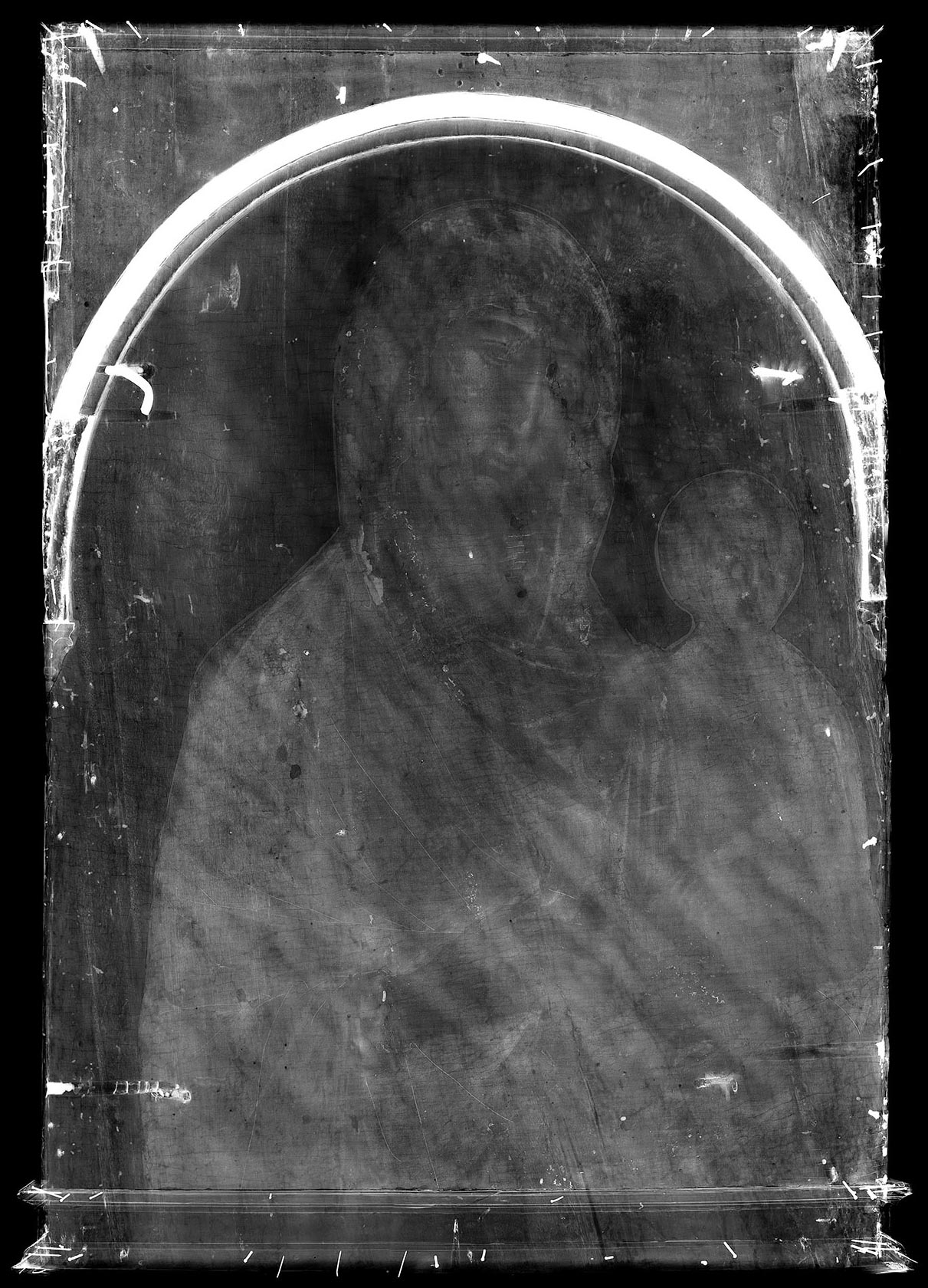

An even more important contribution to the study of Segna di Bonaventura and his Ducciesque contemporaries was advanced by Cateni in 1986, when he recognized a large panel in the Gondi collection in Florence, representing the Virgin and Child Enthroned with Angels, and a fragmentary fresco in the church of San Domenico at Arezzo (fig. 6) as having been painted not by Segna—as had recently been suggested by Boskovits—but by a painter who had, until then, been known only for a handful of highly refined, small-scale works in the style of Segna and given the conventional name of the “Goodhart Ducciesque Master.”14 Alessandro Bagnoli expanded the profile of this accomplished if undervalued artist, whom he proposed renaming the Master of the Gondi Maestà, adding further monumental works in fresco and on panel to his oeuvre and arguing that these are efforts of an earlier period, probably beginning around or before 1310, than were the works assembled around the Goodhart Maestà in the Robert Lehman Collection at the Metropolitan Museum of Art, New York (fig. 7).15 The affinities of this group of works with the Yale Virgin and Child are palpable—far more compelling than those between the Yale painting and the more severe, emotionally distant images of Segna di Bonaventura. Above all, it is the fragmentary fresco in San Domenico, Arezzo, that argues for an attribution of the Yale painting to the Gondi Master. The cartoons for the figures of the Virgin and Child can practically be superimposed from one to the other. The elaborate folds of the Virgin’s white veil, her elongated but gentle facial features, and the almost geometrically spherical head of the Christ Child are nearly identical in both. These traits are all observable, to a greater or lesser degree, in the paintings that had formerly been associated with the Goodhart Maestà, most of which are likely to have been painted in the 1320s. It is plausible to view the Yale panel as emerging from a pivotal moment between these two stylistic periods and to consider it a product of the second decade of the fourteenth century. —LK

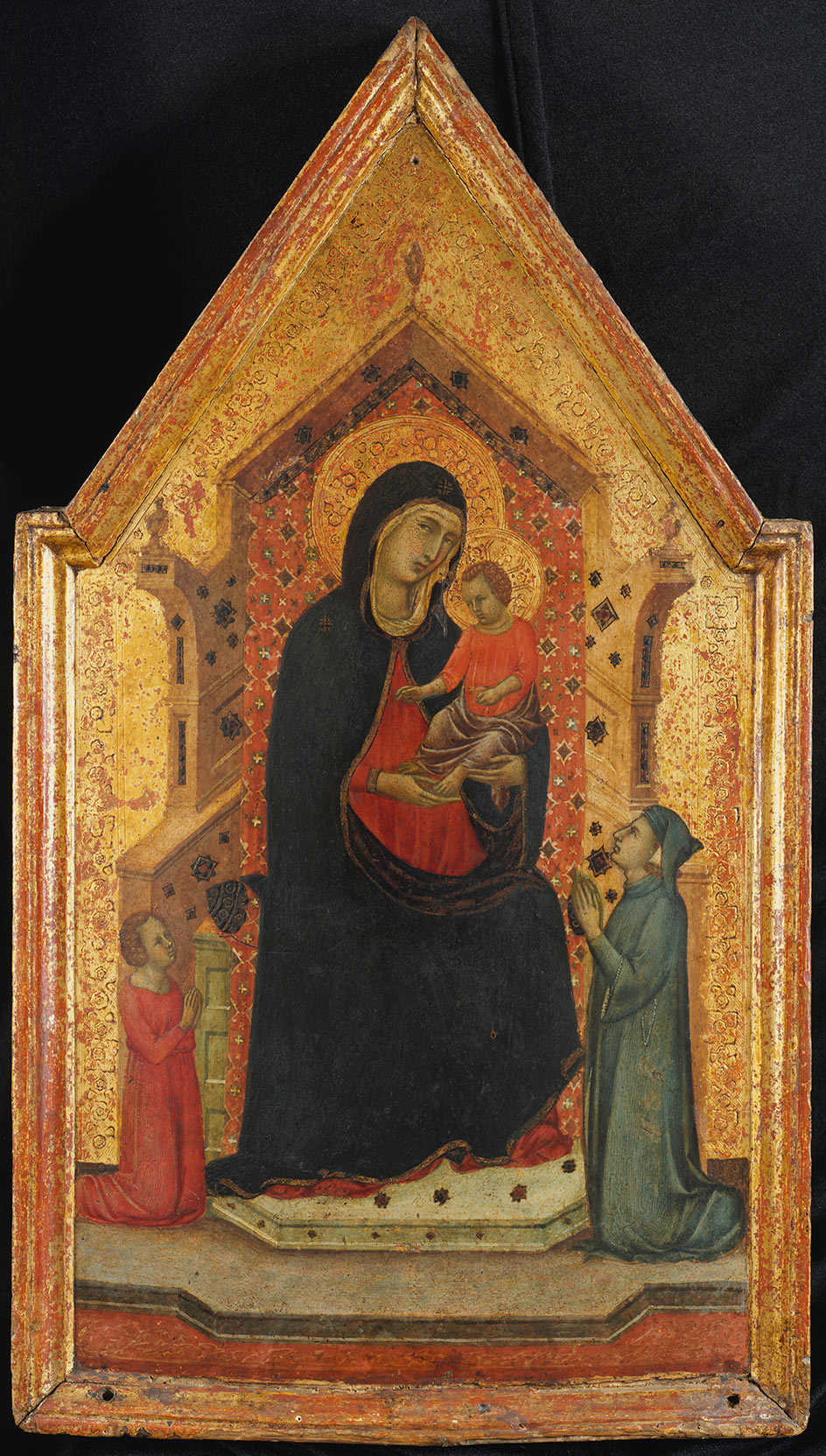
Published References
Crowe, Joseph Archer, and Giovanni Battista Cavalcaselle. A History of Painting in Italy, Umbria, Florence and Siena from the Second to the Sixteenth Century. Vols. 1–4, ed. Robert Langton Douglas. Vols. 5–6, ed. Tancred Borenius. London: J. Murray, 1903–14., 3:28n1; Perkins, F. Mason. “Ancora dei dipinti sconosciuti di scuola senese.” Rassegna d’arte senese 4 (1908): 3–9., 7; De Nicola, Giacomo, ed. Mostra di opere di Duccio di Buoninsegna e della sua scuola. Exh. cat. Siena: Lazzeri, 1912., 23, no. 38; De Nicola, Giacomo. “Duccio di Buoninsegna and His School in the Mostra di Duccio at Siena.” Burlington Magazine 22, no. 117 (December 1912): 138–39, 142–43, 145–47., 143, 146, pl. 2d; van Marle, Raimond. The Development of the Italian Schools of Painting. Vol. 2. The Hague: M. Nijhoff, 1924., 139, 149, figs. 100, 153; Weigelt, Curt. Sienese Painting of the Trecento. New York: Hacker, 1930., 72n32; Brandi, Cesare. Duccio. Florence: Vallecchi, 1951., 156; Stubblebine, James. Duccio di Buoninsegna and His School. Princeton, N.J.: Princeton University Press, 1979., 1:138, 140, 2: fig. 335; Angelelli, Walter, and Andrea G. De Marchi. Pittura dal duecento al primo cinquecento nelle fotografie di Girolamo Bombelli. Milan: Electa, 1991., 255, no. 538; De Marchi, Andrea. Falsi primitivi: Prospettive critiche e metodi di esecuzione. Turin: U. Allemandi, 2001., 158, 187n69, pl. 37; Luciano Cateni, in Bagnoli, Alessandro, Roberto Bartalini, Luciano Bellosi, and Michel Laclotte, eds. Duccio: Alle origini della pittura senese. Exh. cat. Cinisello Balsamo, Milan: Silvana, 2003., 318
Notes
-
Information from label on reverse of panel. ↩︎
-
Langton Douglas, in Crowe, Joseph Archer, and Giovanni Battista Cavalcaselle. A History of Painting in Italy, Umbria, Florence and Siena from the Second to the Sixteenth Century. Vols. 1–4, ed. Robert Langton Douglas. Vols. 5–6, ed. Tancred Borenius. London: J. Murray, 1903–14., 3:28n1; and Perkins, F. Mason. “Ancora dei dipinti sconosciuti di scuola senese.” Rassegna d’arte senese 4 (1908): 3–9., 7. ↩︎
-
“Un lavoro di eccezionale finezza, il quale rivela ben chiaramente le doti non comuni di questo seguace troppo poco apprezzato di Duccio”; Perkins, F. Mason. “Ancora dei dipinti sconosciuti di scuola senese.” Rassegna d’arte senese 4 (1908): 3–9., 7. ↩︎
-
De Nicola, Giacomo, ed. Mostra di opere di Duccio di Buoninsegna e della sua scuola. Exh. cat. Siena: Lazzeri, 1912., 23, no. 38. ↩︎
-
De Nicola, Giacomo. “Duccio di Buoninsegna and His School in the Mostra di Duccio at Siena.” Burlington Magazine 22, no. 117 (December 1912): 138–39, 142–43, 145–47., 143, 146, pl. 2d. ↩︎
-
van Marle, Raimond. The Development of the Italian Schools of Painting. Vol. 2. The Hague: M. Nijhoff, 1924., 139, 149, figs. 100, 153. ↩︎
-
Weigelt, Curt. Sienese Painting of the Trecento. New York: Hacker, 1930., 72n32. ↩︎
-
Brandi, Cesare. Duccio. Florence: Vallecchi, 1951., 156. ↩︎
-
Stubblebine, James. Duccio di Buoninsegna and His School. Princeton, N.J.: Princeton University Press, 1979., 1:138, 140; 2: fig. 335. ↩︎
-
Luciano Cateni, in Bagnoli, Alessandro, Roberto Bartalini, Luciano Bellosi, and Michel Laclotte, eds. Duccio: Alle origini della pittura senese. Exh. cat. Cinisello Balsamo, Milan: Silvana, 2003., 318. See also Boskovits, Miklós. Review of Duccio di Buoninsegna and His School, by James H. Stubblebine, and Duccio: Tuscan Art and the Medieval Workshop, by John White. Art Bulletin 64, no. 3 (September 1982): 496–502., 496–98, for a summary but conscientious dismantling of Stubblebine’s many categories of attribution. Boskovits’s review is not frequently cited, but it has formed the basis for most modern scholarship of this period. ↩︎
-
Joni, Icilio Federico. Le memorie di un pittore di quadri antichi. San Casciano Val di Pesa: n.p., [1932].. Joni’s book was translated in English and published as Affairs of a Painter (London, 1936). ↩︎
-
See Angelelli, Walter, and Andrea G. De Marchi. Pittura dal duecento al primo cinquecento nelle fotografie di Girolamo Bombelli. Milan: Electa, 1991., 255, no. 538. ↩︎
-
Inv. no. 583. ↩︎
-
Cateni, Luciano. “Appunti sul ‘Goodhart Master.’” Prospettiva 45 (April 1986): 63–66., 63–66. For the Goodhart Ducciesque Master, see Pope-Hennessy, John, and Laurence Kanter. The Robert Lehman Collection. Vol. 1, Italian Paintings. New York: Metropolitan Museum of Art, 1987., 6–7 (with previous bibliography). ↩︎
-
Alessandro Bagnoli, “Maestro della Maestà Gondi,” in Bagnoli, Alessandro, Roberto Bartalini, Luciano Bellosi, and Michel Laclotte, eds. Duccio: Alle origini della pittura senese. Exh. cat. Cinisello Balsamo, Milan: Silvana, 2003., 334–43. Several of the paintings aggregated to the Goodhart/Gondi group by Bagnoli had been assembled by Stubblebine (in Stubblebine, James. Duccio di Buoninsegna and His School. Princeton, N.J.: Princeton University Press, 1979., 1:110–16; 2, figs. 267–76) under the name the Casole Fresco Master. Boskovits (in Boskovits, Miklós. Review of Duccio di Buoninsegna and His School, by James H. Stubblebine, and Duccio: Tuscan Art and the Medieval Workshop, by John White. Art Bulletin 64, no. 3 (September 1982): 496–502., 497) noted that the Casole Fresco Master was actually a combination of works by the Master of Città di Castello and Segna, the latter being the paintings that Bagnoli recognized instead as belonging with the Gondi Maestà. Note that the captions for two illustrations in Bagnoli’s study are reversed: the fresco in San Domenico, Arezzo, is illustrated on p. 339, not p. 338. For this fresco, see also Stubblebine, James. Duccio di Buoninsegna and His School. Princeton, N.J.: Princeton University Press, 1979., 1:111–12, 2: fig. 268. ↩︎
